-
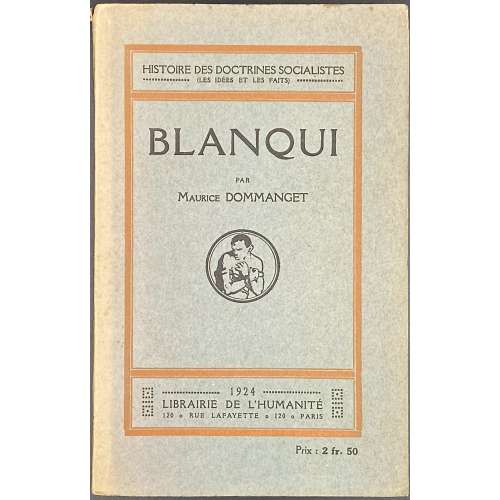 Front wrapper: In the three-compartment orange frame: 1st compartment: HISTOIRE DES DOCTRINES SOCIALISTES | *** (LES IDÉES ET LES FAITS) *** | 2nd compartment: BLANQUI | PAR | Maurice DOMMANGET | {circular device} | 3rd compartment: *** 1924 *** | LIBRAIRIE DE L'HUMANITÉ | 120 • RUE LAFAYETTE • 120 PARIS | Under the frame : Prix : 2 fr. 50 || Title page: HISTOIRE DES DOCTRINES SOCIALISTES | *** (LES IDÉES ET LES FAITS) *** | BLANQUI | PAR Maurice DOMMANGET | {device in a circle} | *** 1924 *** | LIBRAIRIE DE L'HUMANITÉ | 120 • RUE LAFAYETTE • 120 PARIS || Back wrapper: Advert. in an orange frame. Pagination: wrappers included in pagination ; [1-5] 6-95 [96-98] (total 49 leaves incl. wrappers). Collation: wrappers not included in collation: [1]-68. Binding: 18.5 x 12 cm; publisher’s blue wrappers with an orange frame, black lettering to covers and spine; uncut. Russian translation: LIB-2747.2021
Front wrapper: In the three-compartment orange frame: 1st compartment: HISTOIRE DES DOCTRINES SOCIALISTES | *** (LES IDÉES ET LES FAITS) *** | 2nd compartment: BLANQUI | PAR | Maurice DOMMANGET | {circular device} | 3rd compartment: *** 1924 *** | LIBRAIRIE DE L'HUMANITÉ | 120 • RUE LAFAYETTE • 120 PARIS | Under the frame : Prix : 2 fr. 50 || Title page: HISTOIRE DES DOCTRINES SOCIALISTES | *** (LES IDÉES ET LES FAITS) *** | BLANQUI | PAR Maurice DOMMANGET | {device in a circle} | *** 1924 *** | LIBRAIRIE DE L'HUMANITÉ | 120 • RUE LAFAYETTE • 120 PARIS || Back wrapper: Advert. in an orange frame. Pagination: wrappers included in pagination ; [1-5] 6-95 [96-98] (total 49 leaves incl. wrappers). Collation: wrappers not included in collation: [1]-68. Binding: 18.5 x 12 cm; publisher’s blue wrappers with an orange frame, black lettering to covers and spine; uncut. Russian translation: LIB-2747.2021 -
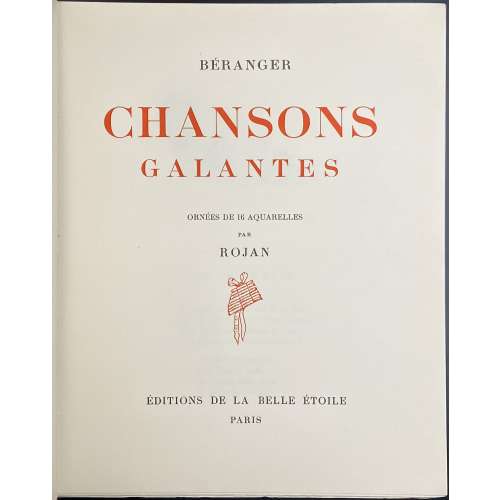 Cover (in red and black): BÉRANGER | CHANSONS | GALANTES | {vignette} || Title page (in red and black): BÉRANGER | CHANSONS | GALANTES | ORNEES DE 16 AQUARELLES | PAR | ROJAN | {vignette} | ÉDITIONS DE LA BELLE ÉTOILE | PARIS || Pagination: [2] – front wrapper, [2] – blank, [1-4] 5-157 [3] [2] blank, [2] – back wrapper; the total number of pages 168 + 16 plates, numerous in-text head- and tailpieces in black. Collation: 4to; [1] 2-214, wrapped leaves included in collation; the total number of leaves 84 + 16 plates. Colour illustrations: 16 full-page colour plates and 4 colour headpieces are produced by the so-called Duval-Beaufumé process (collotype and stencil) of reproductions after Rojan’s watercolours. Tirage: Limited edition of 1500 copies, of which this is № 1434. Binding: Publisher's French flapped cream wrappers with red and black lettering to front wrapper and black lettering to spine, wove paper (vélin Navarre), uncut. Size: 243 x 195 mm. Contributors: Béranger, Pierre-Jean de (French, 1780 – 1857) – author. Rojankovsky, Feodor [Rojan; Рожанковский, Фёдор Степанович] (Russian-American, 1891 – 1970) – artist. NOTE on technique: Micro-photography reveals that this is not a collotype but some sort of photochemical reproduction method, such as a halftone screen. The colour was applied with a stencil, indeed.
Cover (in red and black): BÉRANGER | CHANSONS | GALANTES | {vignette} || Title page (in red and black): BÉRANGER | CHANSONS | GALANTES | ORNEES DE 16 AQUARELLES | PAR | ROJAN | {vignette} | ÉDITIONS DE LA BELLE ÉTOILE | PARIS || Pagination: [2] – front wrapper, [2] – blank, [1-4] 5-157 [3] [2] blank, [2] – back wrapper; the total number of pages 168 + 16 plates, numerous in-text head- and tailpieces in black. Collation: 4to; [1] 2-214, wrapped leaves included in collation; the total number of leaves 84 + 16 plates. Colour illustrations: 16 full-page colour plates and 4 colour headpieces are produced by the so-called Duval-Beaufumé process (collotype and stencil) of reproductions after Rojan’s watercolours. Tirage: Limited edition of 1500 copies, of which this is № 1434. Binding: Publisher's French flapped cream wrappers with red and black lettering to front wrapper and black lettering to spine, wove paper (vélin Navarre), uncut. Size: 243 x 195 mm. Contributors: Béranger, Pierre-Jean de (French, 1780 – 1857) – author. Rojankovsky, Feodor [Rojan; Рожанковский, Фёдор Степанович] (Russian-American, 1891 – 1970) – artist. NOTE on technique: Micro-photography reveals that this is not a collotype but some sort of photochemical reproduction method, such as a halftone screen. The colour was applied with a stencil, indeed.
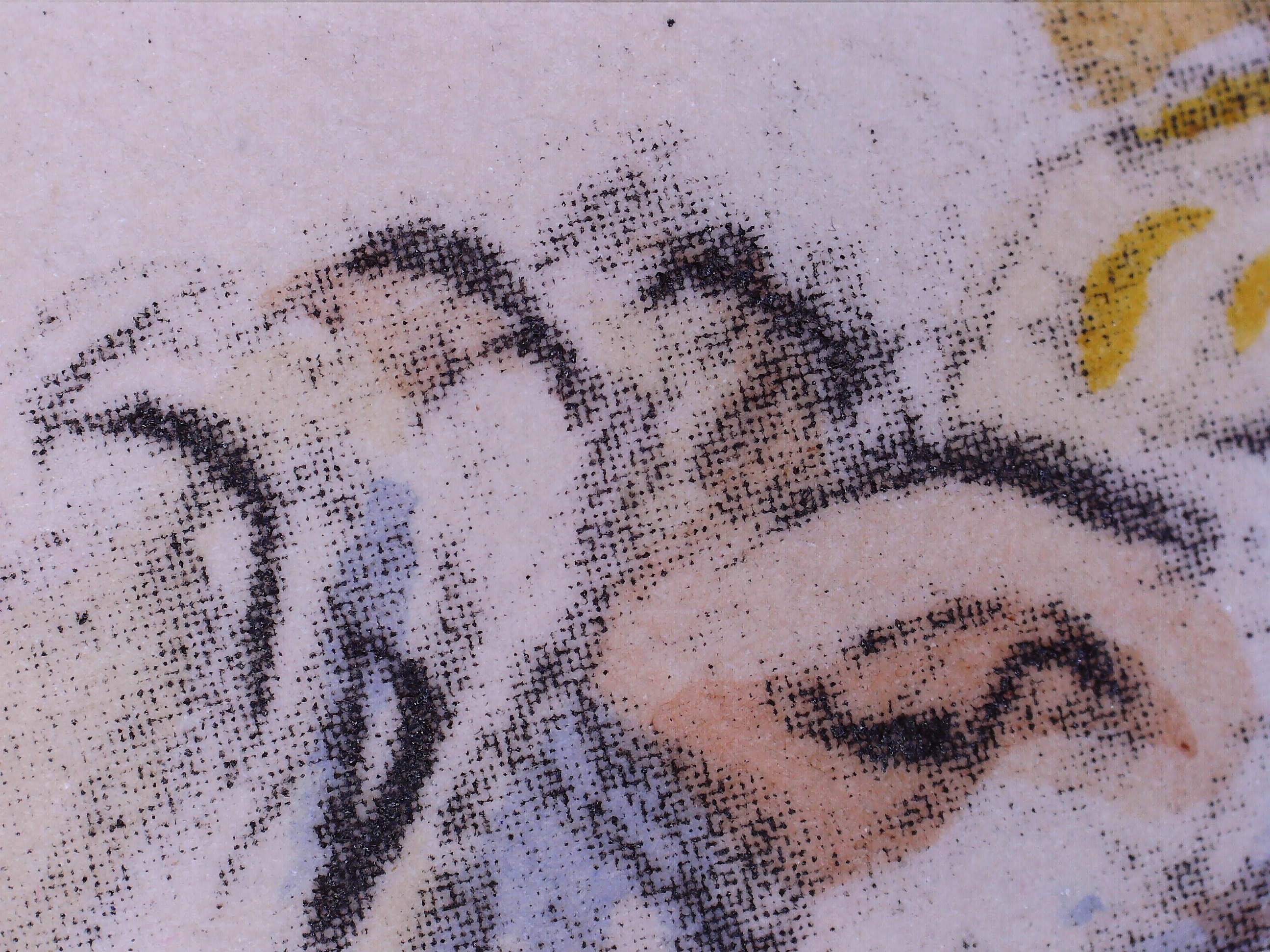
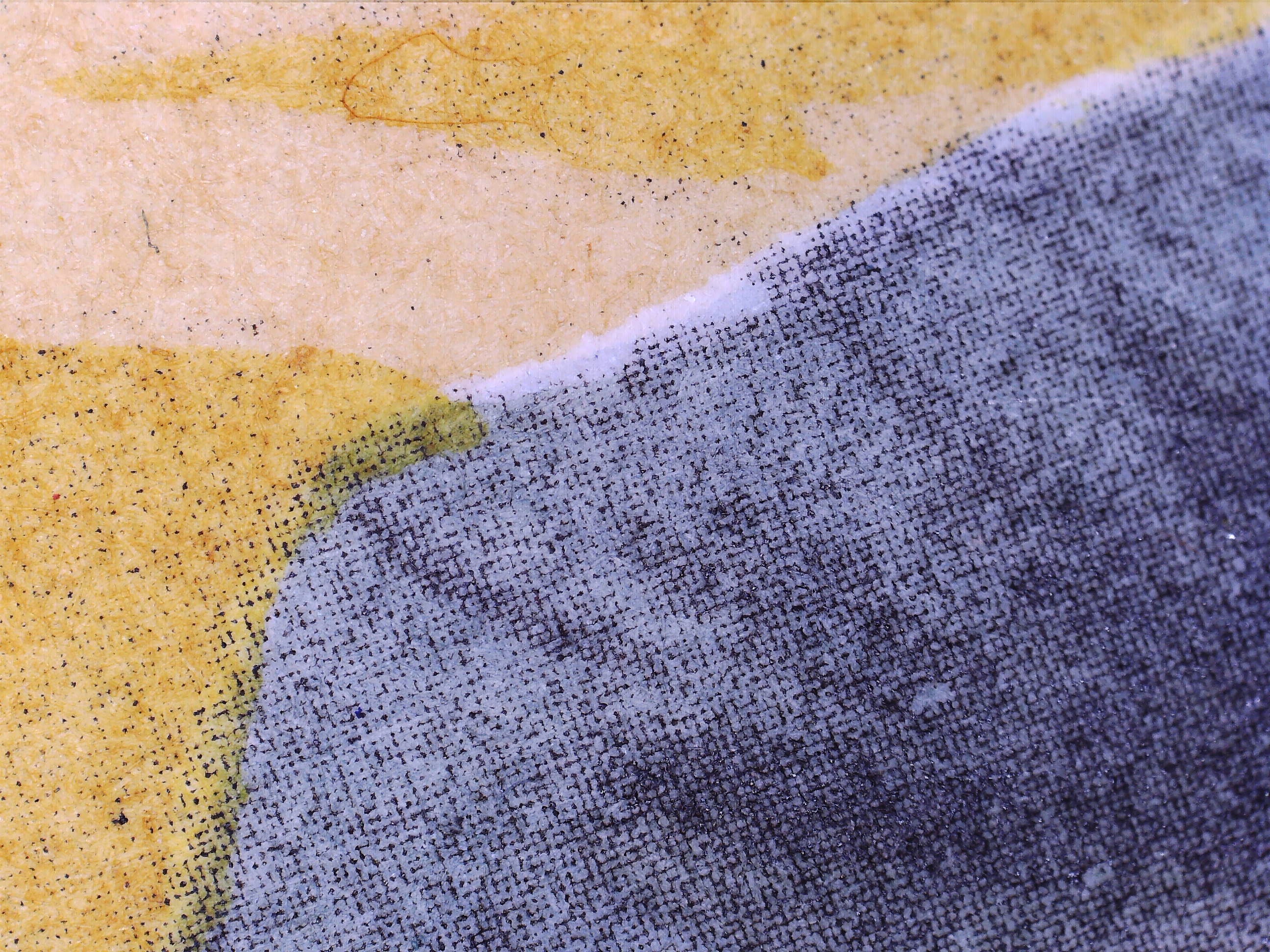
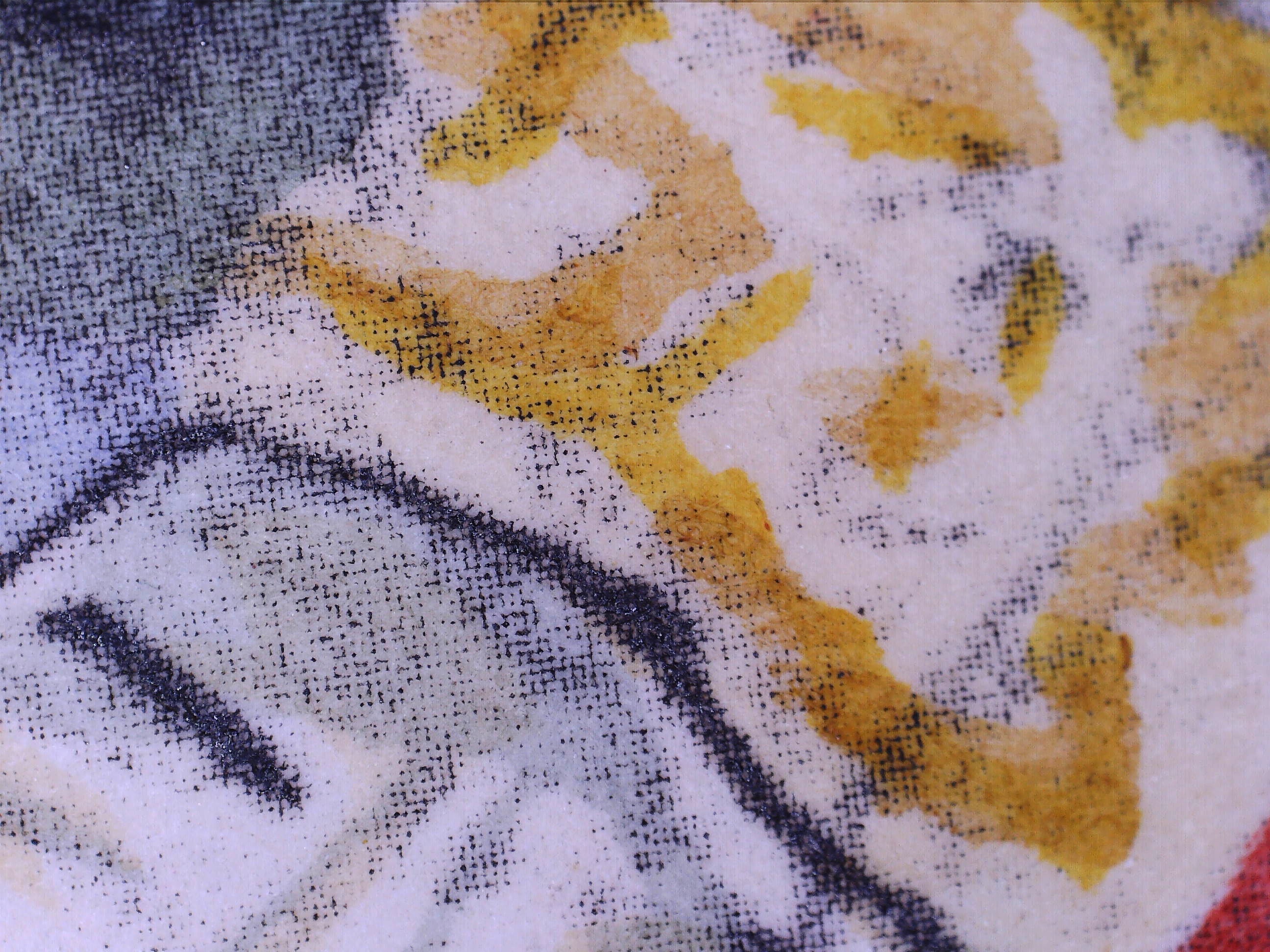
-
![Gordon N. Ray. The Art of the French Illustrated Book 1700 to 1914 (2 vol. set). — NY, London: The Pierpont Morgan Library; Cornell University Press, 1982. — pp.: vol.1: [8] ix-xxxii, [2] 3-245 [3]; vol.2: [8] 247-557 [5], illustr.](https://varshavskycollection.com/wp-content/uploads/2021/02/LIB-2424.2020-scaled-500x500.jpeg) Title page: The Art of the | French Illustrated Book | 1700 to 1914 | VOLUME I (II) | Gordon N. Ray | The Pierpont Morgan Library | Cornell University Press || Pagination: vol.1: [8] ix-xxxii, [2] 3-245 [3], illustr.; vol.2: [8] 247-557 [5], illustr. Both volumes paginater through out. Binding: 30.5 x 23.5 cm, two volumes uniformly bound in red cloth, gilt vignette to front cover, gilt lettering to spine; bookplate to front pastedown, ex-lib (Sweet Briar College Library) Contributors: Ray, Gordon Norton (American, 1915 – 1986) – author. Lange, Thomas V. – formal bibliographical description. Passela, Charles V. – photography. The Pierpont Morgan Library – Copyright © 1982
Title page: The Art of the | French Illustrated Book | 1700 to 1914 | VOLUME I (II) | Gordon N. Ray | The Pierpont Morgan Library | Cornell University Press || Pagination: vol.1: [8] ix-xxxii, [2] 3-245 [3], illustr.; vol.2: [8] 247-557 [5], illustr. Both volumes paginater through out. Binding: 30.5 x 23.5 cm, two volumes uniformly bound in red cloth, gilt vignette to front cover, gilt lettering to spine; bookplate to front pastedown, ex-lib (Sweet Briar College Library) Contributors: Ray, Gordon Norton (American, 1915 – 1986) – author. Lange, Thomas V. – formal bibliographical description. Passela, Charles V. – photography. The Pierpont Morgan Library – Copyright © 1982 -
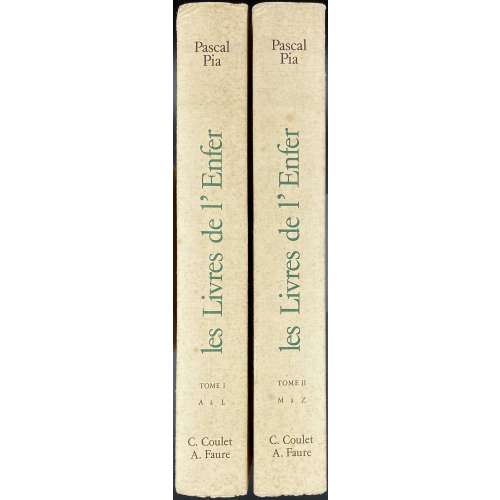 Vol. 1: Front wrapper (green and black): Pascal Pia | les | Livres | de l'Enfer | du XVIeme siècle à nos jours | TOME I | C. Coulet et A. Faure || Title page: Pascal Pia | les | Livres (historiated initial «L») | de l'Enfer | Bibliographie critique des ouvrages | érotiques dans leurs différentes | éditions du XVIe siècle à nos jours. | Tome I | A à L | C. Coulet et A. Faure | 5 rue Drouot | Paris 9e | 1978 || Pagination: [1-6] 7-413 [414]. Vol. 2: Front wrapper similar to Vol. 1 but “TOME II”; title similar to Vol. 1 but “Tome II | M à Z”. Pagination: [6] 415-837 [838] [2] – colophon / blank. Entries in the main sections are not numbered, each page has two columns of text and the columns are numbered 1-778 in vol. 1 and 779-1440 in vol. 2; p. 751– 792 – l'enfer BNF (numbered list); pp. 793-837 – index of authors, artists, editors, publishers, etc. Edition: 1st; limited to 900 copies, first 100 numbered 1-100 and printed on Ingres paper, next 800 numbered 1-800 and printed on Centaure Ivoire paper. This copy is № 34 (stamped in black) from the first hundred. Binding: 25 x 16.5 cm, both volumes printed on laid watermarked paper “Ingres”, untrimmed, uncut, uniformly bound in publisher’s wrappers lettered on front and spine. Contributors: Pascal Pia [Pierre Durand] (French, 1903 – 1979) – author/compiler. Imprimerie centrale de l'Ouest (Roche-sur-Yon) – printer.
Vol. 1: Front wrapper (green and black): Pascal Pia | les | Livres | de l'Enfer | du XVIeme siècle à nos jours | TOME I | C. Coulet et A. Faure || Title page: Pascal Pia | les | Livres (historiated initial «L») | de l'Enfer | Bibliographie critique des ouvrages | érotiques dans leurs différentes | éditions du XVIe siècle à nos jours. | Tome I | A à L | C. Coulet et A. Faure | 5 rue Drouot | Paris 9e | 1978 || Pagination: [1-6] 7-413 [414]. Vol. 2: Front wrapper similar to Vol. 1 but “TOME II”; title similar to Vol. 1 but “Tome II | M à Z”. Pagination: [6] 415-837 [838] [2] – colophon / blank. Entries in the main sections are not numbered, each page has two columns of text and the columns are numbered 1-778 in vol. 1 and 779-1440 in vol. 2; p. 751– 792 – l'enfer BNF (numbered list); pp. 793-837 – index of authors, artists, editors, publishers, etc. Edition: 1st; limited to 900 copies, first 100 numbered 1-100 and printed on Ingres paper, next 800 numbered 1-800 and printed on Centaure Ivoire paper. This copy is № 34 (stamped in black) from the first hundred. Binding: 25 x 16.5 cm, both volumes printed on laid watermarked paper “Ingres”, untrimmed, uncut, uniformly bound in publisher’s wrappers lettered on front and spine. Contributors: Pascal Pia [Pierre Durand] (French, 1903 – 1979) – author/compiler. Imprimerie centrale de l'Ouest (Roche-sur-Yon) – printer. -
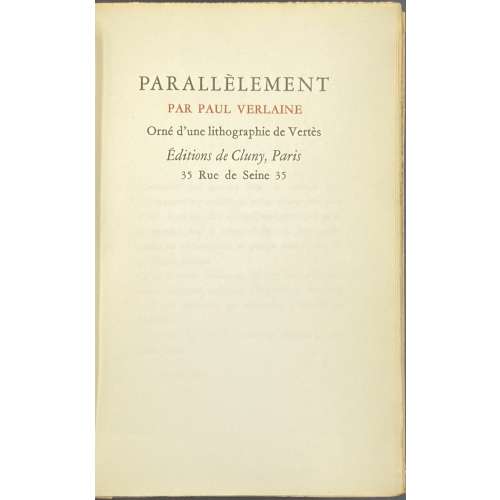 Title-page (in red and black): PARALLELEMENT | PAR PAUL VERLAINE | Orné d’une lithographie de Vertès | Éditions de Cluny, Paris | 35 Rue de Seine 35 || Description: 18.8 x 12.4 cm, French flapped cream wrappers lettered to front and spine, 1st blank leaf, [1-2] h.t. in red / limitation, 3-4] t.p. / blank, 5-127 [128], last blank leaf, plus frontispiece (colour lithography) by Marcel Vertès. Edition: printed on December 5, 1934, by Ducros & Colas in Paris, limited to 2 copies on Japon Nacré (A and B); 3,000 copies on Vergé de Voiron (1-3,000); and several not for sale copies on Papier d’Arches, numbered with Roman numbers. This copy is №282. Contributors: Paul Verlaine (French, 1844 – 1896) – author. Marcel Vertès [Marcell Vértes] (Jewish-Hungarian-French, 1895 – 1961) – artist. Maitres-imprimeurs Ducros et Colas (Paris) – printer. Éditions de Cluny (Paris) – publisher. Other names: Marcel Vertès, Marcel Vertes, Marcell Vértes
Title-page (in red and black): PARALLELEMENT | PAR PAUL VERLAINE | Orné d’une lithographie de Vertès | Éditions de Cluny, Paris | 35 Rue de Seine 35 || Description: 18.8 x 12.4 cm, French flapped cream wrappers lettered to front and spine, 1st blank leaf, [1-2] h.t. in red / limitation, 3-4] t.p. / blank, 5-127 [128], last blank leaf, plus frontispiece (colour lithography) by Marcel Vertès. Edition: printed on December 5, 1934, by Ducros & Colas in Paris, limited to 2 copies on Japon Nacré (A and B); 3,000 copies on Vergé de Voiron (1-3,000); and several not for sale copies on Papier d’Arches, numbered with Roman numbers. This copy is №282. Contributors: Paul Verlaine (French, 1844 – 1896) – author. Marcel Vertès [Marcell Vértes] (Jewish-Hungarian-French, 1895 – 1961) – artist. Maitres-imprimeurs Ducros et Colas (Paris) – printer. Éditions de Cluny (Paris) – publisher. Other names: Marcel Vertès, Marcel Vertes, Marcell Vértes -
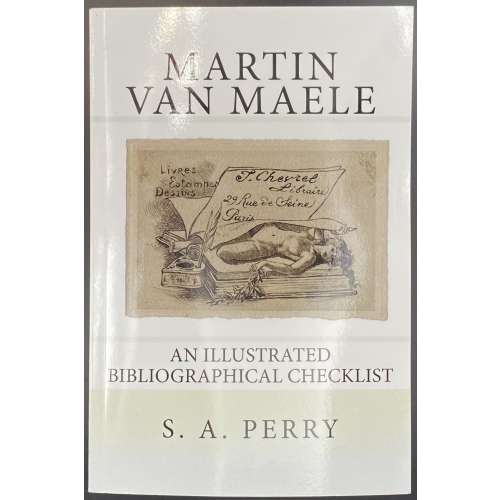 Printed on-demand, pictorial softcover, 22.9 x 15.2 cm, front: MARTIN | VAN MAELE |{fac-simile il.}| AN ILLUSTRATED | BIBLIOGRAPHICAL CHECKLIST | S. A. PERRY ||, blurb to back, lettering to spine, pp.: [12] [1] 2-207 [3] (total 222 pages), 107 reproductions of van Maele illustrations, 94 items bibliographical description. Title-page: S. A. PERRY. | Martin Van Maele | An Illustrated Bibliographical Checklist | 2015 || in a double-fillet frame. Colophon: Made in the USA | Las Vegas, NV | 26 December 2021. Maurice François Alfred Martin van Maële [Martin van Maële] (French, 1863 – 1926).
Printed on-demand, pictorial softcover, 22.9 x 15.2 cm, front: MARTIN | VAN MAELE |{fac-simile il.}| AN ILLUSTRATED | BIBLIOGRAPHICAL CHECKLIST | S. A. PERRY ||, blurb to back, lettering to spine, pp.: [12] [1] 2-207 [3] (total 222 pages), 107 reproductions of van Maele illustrations, 94 items bibliographical description. Title-page: S. A. PERRY. | Martin Van Maele | An Illustrated Bibliographical Checklist | 2015 || in a double-fillet frame. Colophon: Made in the USA | Las Vegas, NV | 26 December 2021. Maurice François Alfred Martin van Maële [Martin van Maële] (French, 1863 – 1926). -
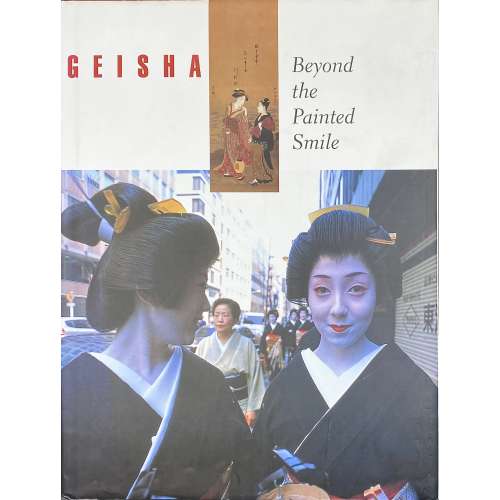 Description: one volume, 31.3 x 23.8 cm, bound in crimson cloth with gilt lettering to spine, in a pictorial dust jacket, lettered to front: GEISHA | {image} | Beyond | the | Painted | Smile | {image} || Title-page: GEISHA | Beyond | the | Painted | Smile | edited by the | Peabody Essex | Museum | published by | George Braziller, Inc. | in association with the | Peabody Essex Museum || Pagination: 1-159 [160], ils. Contributors: Lisa Dalby, Lesley Downer, Arthur Golden, Peter M. Grilli, Money L. Hickman, Allen Hockley, Andrew L. Maske, Yoko Yamamoto.
Description: one volume, 31.3 x 23.8 cm, bound in crimson cloth with gilt lettering to spine, in a pictorial dust jacket, lettered to front: GEISHA | {image} | Beyond | the | Painted | Smile | {image} || Title-page: GEISHA | Beyond | the | Painted | Smile | edited by the | Peabody Essex | Museum | published by | George Braziller, Inc. | in association with the | Peabody Essex Museum || Pagination: 1-159 [160], ils. Contributors: Lisa Dalby, Lesley Downer, Arthur Golden, Peter M. Grilli, Money L. Hickman, Allen Hockley, Andrew L. Maske, Yoko Yamamoto. -
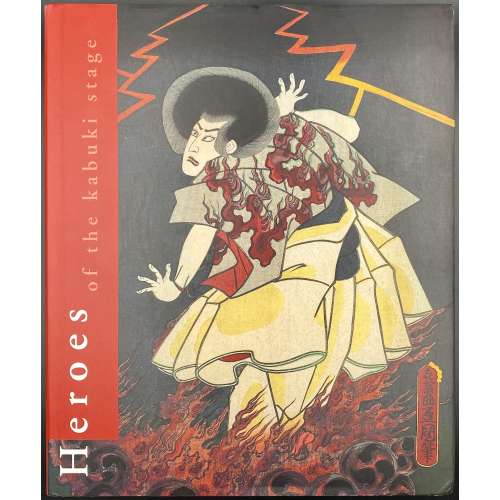 One hardcover volume, 30.2 x 25.3 cm, in red cloth blind stamped to front and spine with lettering, in pictorial dust jacket; pp.: [1-4] 5-359 [360], total 180 leaves, profusely illustrated. Subject: Japan; Theatre; Kabuki theatre; Kabuki actors; Woodblock prints. Contributors: Arendie Herwig (Dutch, fl. 2002 – 2016); Henk Herwig (Dutch, fl. 2002 – 2017).
One hardcover volume, 30.2 x 25.3 cm, in red cloth blind stamped to front and spine with lettering, in pictorial dust jacket; pp.: [1-4] 5-359 [360], total 180 leaves, profusely illustrated. Subject: Japan; Theatre; Kabuki theatre; Kabuki actors; Woodblock prints. Contributors: Arendie Herwig (Dutch, fl. 2002 – 2016); Henk Herwig (Dutch, fl. 2002 – 2017). -
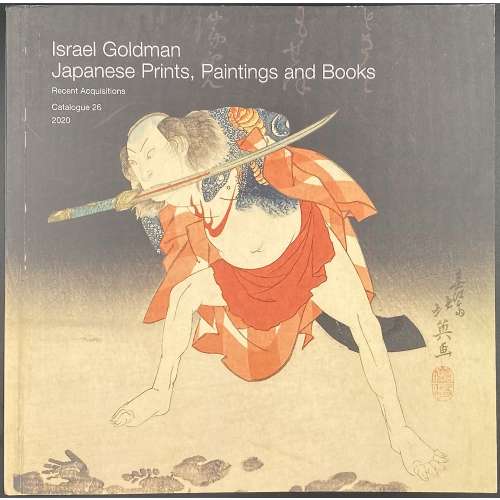 Softcover, pictorial wrappers, square 21 x 21 cm, 46 leaves, unpaginated, with illustrations in colour, 89 entries, with price list laid in; limited edition of 700 copies. Contributor: Israel Goldman In this collection:
Softcover, pictorial wrappers, square 21 x 21 cm, 46 leaves, unpaginated, with illustrations in colour, 89 entries, with price list laid in; limited edition of 700 copies. Contributor: Israel Goldman In this collection:
SVJP-0327.2020: Kunisada. Ichikawa Ebizo V (Danjuro VII) in a Shibaraku role / Ōban, 1822; # 50 in the Catalogue.
-
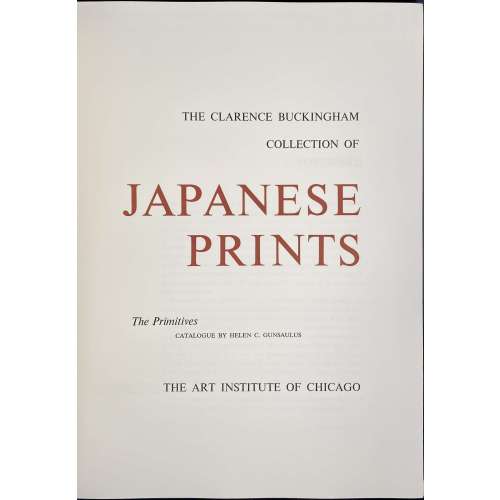 Two volumes, each bound in red cloth with gilt lettering to spine, black endpapers, TEG, and matching red cloth slipcases with black lettering to front. Vol. 1: The Clarence Buckingham collection of Japanese prints: The Primitives / Catalogue by Helen C. Gunsaulus. — [Chicago]: Art Institute of Chicago, 1955. Pagination: 1st leaf blank, 2nd leaf half-title, verso blank, [i, ii] – t.p. in red and black, copyright to verso, iii-vi, [vii] faux-title “The catalogue”, 1-284 [285] colophon, limitation: 500 numbered copies, this is № 476. Title-page: THE CLARENCE BUCKINGHAM | COLLECTION OF | JAPANESE PRINTS | The Primitives | CATALOGUE BY HELEN C. GUNSAULUS | THE ART INSTITUTE OF CHICAGO || Vol. 2: The Clarence Buckingham collection of Japanese prints: Volume 2 / Catalogue by Margaret O. Gentles. — [Chicago]: Art Institute of Chicago, 1965. Pagination: 1st leaf blank, 2nd leaf half-title, verso blank, [i, ii] – t.p. in red and black, copyright to verso, iii-vi, [vii] faux-title “The catalogue”,1-307 [2] blank/ colophon, limitation: 1000 copies (unnumbered). Title-page: VOLUME II | THE CLARENCE BUCKINGHAM | COLLECTION OF | JAPANESE PRINTS | Harunobu, Koryūsai, Shigemasa, their followers and contemporaries | Catalogue by Margaret O. Gentles | THE ART INSTITUTE OF CHICAGO 1965 || Contributors: Clarence Buckingham (American, 1854 – 1913) Helen C. Gunsaulus (American, 1886 – 1954) Margaret O. Gentles (American, 1905 – 1969)
Two volumes, each bound in red cloth with gilt lettering to spine, black endpapers, TEG, and matching red cloth slipcases with black lettering to front. Vol. 1: The Clarence Buckingham collection of Japanese prints: The Primitives / Catalogue by Helen C. Gunsaulus. — [Chicago]: Art Institute of Chicago, 1955. Pagination: 1st leaf blank, 2nd leaf half-title, verso blank, [i, ii] – t.p. in red and black, copyright to verso, iii-vi, [vii] faux-title “The catalogue”, 1-284 [285] colophon, limitation: 500 numbered copies, this is № 476. Title-page: THE CLARENCE BUCKINGHAM | COLLECTION OF | JAPANESE PRINTS | The Primitives | CATALOGUE BY HELEN C. GUNSAULUS | THE ART INSTITUTE OF CHICAGO || Vol. 2: The Clarence Buckingham collection of Japanese prints: Volume 2 / Catalogue by Margaret O. Gentles. — [Chicago]: Art Institute of Chicago, 1965. Pagination: 1st leaf blank, 2nd leaf half-title, verso blank, [i, ii] – t.p. in red and black, copyright to verso, iii-vi, [vii] faux-title “The catalogue”,1-307 [2] blank/ colophon, limitation: 1000 copies (unnumbered). Title-page: VOLUME II | THE CLARENCE BUCKINGHAM | COLLECTION OF | JAPANESE PRINTS | Harunobu, Koryūsai, Shigemasa, their followers and contemporaries | Catalogue by Margaret O. Gentles | THE ART INSTITUTE OF CHICAGO 1965 || Contributors: Clarence Buckingham (American, 1854 – 1913) Helen C. Gunsaulus (American, 1886 – 1954) Margaret O. Gentles (American, 1905 – 1969) -
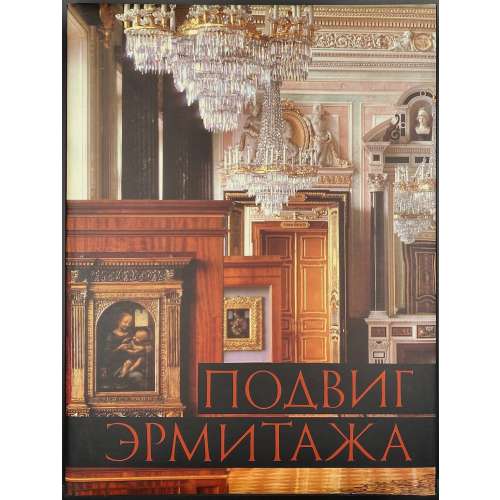 Title-page (in red on pictorial background): ПОДВИГ | ЭРМИТАЖА | ИЗДАТЕЛЬСТВО «АВРОРА» • ЛЕНИНГРАД || Illustrated album in hardcover, 33 x 25 cm, bound in black cloth with gilt and red to front cover and spine, brown endpapers, pictorial dust jacket; pp.: [1-6] 7-273 [274] [30], total 304 pages with 388 b/w and colour illustrations. Text: Sergei Petrovich Varshavsky [Сергей Петрович Варшавский] (Jewish-Russian, 1906 – 1980); B. Rest [Б. Рест; Юлий Исаакович Шапиро] (Jewish-Russian, fl. 1940 – 1980). Preface: Boris Piotrovsky [Борис Борисович Пиотровский] (Russian, 1908 – 1990). Layout by Liubov Rakhmilevich [Л. Рахмилевич]. Photography by Viktor Savik [В. Савик] and Leonid Bogdanov [Л. Богданов]. Design by Valery Ivanov [В. Иванов]. Russian twin edition to [LIB-3043.2022] S. Varshavsky, B. Rest. Saved for humanity: the Hermitage during the siege of Leningrad, 1941-1944. — Leningrad: Aurora Art Publishers, 1985 and [LIB-3042.2022] The ordeal of the Hermitage: The siege of Leningrad, 1941-1944 — Leningrad: Aurora Art Publishers, New York: Harry N. Abrams, Inc., 1985. The text extracted from [LIB-3035.2022] С. Варшавский, Б. Рест. Подвиг Эрмитажа: Государственный Эрмитаж в годы Великой отечественной войны. — М.-Л.: Советский художник, 1965.
Title-page (in red on pictorial background): ПОДВИГ | ЭРМИТАЖА | ИЗДАТЕЛЬСТВО «АВРОРА» • ЛЕНИНГРАД || Illustrated album in hardcover, 33 x 25 cm, bound in black cloth with gilt and red to front cover and spine, brown endpapers, pictorial dust jacket; pp.: [1-6] 7-273 [274] [30], total 304 pages with 388 b/w and colour illustrations. Text: Sergei Petrovich Varshavsky [Сергей Петрович Варшавский] (Jewish-Russian, 1906 – 1980); B. Rest [Б. Рест; Юлий Исаакович Шапиро] (Jewish-Russian, fl. 1940 – 1980). Preface: Boris Piotrovsky [Борис Борисович Пиотровский] (Russian, 1908 – 1990). Layout by Liubov Rakhmilevich [Л. Рахмилевич]. Photography by Viktor Savik [В. Савик] and Leonid Bogdanov [Л. Богданов]. Design by Valery Ivanov [В. Иванов]. Russian twin edition to [LIB-3043.2022] S. Varshavsky, B. Rest. Saved for humanity: the Hermitage during the siege of Leningrad, 1941-1944. — Leningrad: Aurora Art Publishers, 1985 and [LIB-3042.2022] The ordeal of the Hermitage: The siege of Leningrad, 1941-1944 — Leningrad: Aurora Art Publishers, New York: Harry N. Abrams, Inc., 1985. The text extracted from [LIB-3035.2022] С. Варшавский, Б. Рест. Подвиг Эрмитажа: Государственный Эрмитаж в годы Великой отечественной войны. — М.-Л.: Советский художник, 1965. -
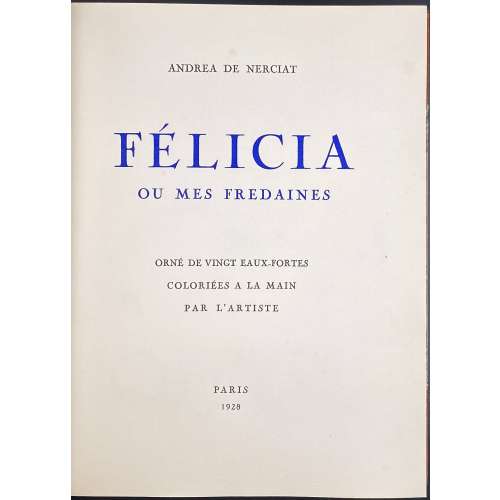 Description: Hardcover, 24.5 x 20 cm, collated 4to, modern half crushed Morocco over marbled boards, raised bands, gilt fillets, fleurons, and lettering to spine, top margin gilt; pp.: [4] [1-5] 6-238 [2] [4]; 1-314, total 124 leaves, 20 in-text vignettes in colour after André Collot, b/w tail-pieces; printed on BFK Rives watermarked wove paper; original wrappers absent. Limitation: Print run of 331 copies of which this is copy № 255. Title-page (blue and black): ANDREA DE NERCIAT | FÉLICIA | OU MES FREDAINES | ORNÉ DE VINGT EAUX-FORTES | COLORIÉES A LA MAIN | PAR L'ARTISTE | PARIS | 1928 || Catalogue raisonné: Dutel (1920-1970) № 1556, p. 165. Contributors: André-Robert Andréa de Nerciat (French, 1739 – 1800) – author. André Collot (French, 1897 – 1976) – artist. Another copy of the same title with illustrations after Louis Icart in this collection: LIB-3046.2022.
Description: Hardcover, 24.5 x 20 cm, collated 4to, modern half crushed Morocco over marbled boards, raised bands, gilt fillets, fleurons, and lettering to spine, top margin gilt; pp.: [4] [1-5] 6-238 [2] [4]; 1-314, total 124 leaves, 20 in-text vignettes in colour after André Collot, b/w tail-pieces; printed on BFK Rives watermarked wove paper; original wrappers absent. Limitation: Print run of 331 copies of which this is copy № 255. Title-page (blue and black): ANDREA DE NERCIAT | FÉLICIA | OU MES FREDAINES | ORNÉ DE VINGT EAUX-FORTES | COLORIÉES A LA MAIN | PAR L'ARTISTE | PARIS | 1928 || Catalogue raisonné: Dutel (1920-1970) № 1556, p. 165. Contributors: André-Robert Andréa de Nerciat (French, 1739 – 1800) – author. André Collot (French, 1897 – 1976) – artist. Another copy of the same title with illustrations after Louis Icart in this collection: LIB-3046.2022. -
 Hardcover, 28 x 19 cm, black cloth with gilt lettering to spine, red pictorial dust jacket; pp.: [i-vii] viii-x [2] [1] 2-540 [8], total 560 pages, profusely illustrated. Title-page: The private library | ~ | Being a More or Less Compendious Disquisition | on | The History of the Architecture and | Furnishing of the Domestic Bookroom | ☙ ❧ | Reid Byers | {publisher’s device} | New Castle, Delaware | 2021 || ISBN: 9781584563884 Author: Reid Byers (American).
Hardcover, 28 x 19 cm, black cloth with gilt lettering to spine, red pictorial dust jacket; pp.: [i-vii] viii-x [2] [1] 2-540 [8], total 560 pages, profusely illustrated. Title-page: The private library | ~ | Being a More or Less Compendious Disquisition | on | The History of the Architecture and | Furnishing of the Domestic Bookroom | ☙ ❧ | Reid Byers | {publisher’s device} | New Castle, Delaware | 2021 || ISBN: 9781584563884 Author: Reid Byers (American). -
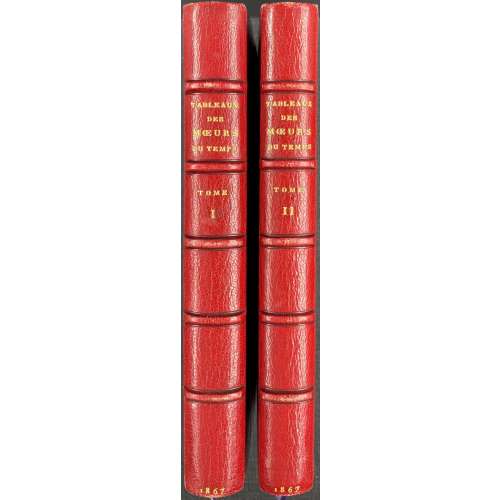 Two volumes in-12, 16.8 x 11.5 cm each, uniformly bound in ¾ red crushed morocco over marbled boards, spine with raised bands and gilt lettering, marbled endpapers, text printed on laid paper, 6 plates (3 in each vol.) on India paper pasted in on thick laid paper leaves. This edition seems similar to Nordmann I 203 but without Félicien Rops' frontispiece and plates, replaced by unsigned etchings attributed to Gustave Staal. Title-page (red and black): LE RICHE DE LA POPELINIÈRE | – | TABLEAUX | DES | MŒURS DU TEMPS | DANS LES DIFFÉRENTS AGES DE LA VIE | – | NOTICE DE | CHARLES MONSELET | – | TOME PREMIER (SECOND) | {fleuron} | PARIS | IMPRIMERIE DES CI-DEVANT FERMIERS GÉNÉRAUX | – | M D CCC L XVII || Vol. 1: π2 (h.t., t.p.) a4 (Notice), 1-1312 151 (Table); total 91 leaves plus three leaves of plates. Pagination: [4] [i] ii-vii [viii] [3] 4-168 [2]; total 182 pp, ils. facing pp. 59, 78, and 94. Vol. 2: π2 (h.t., t.p.), 1-1312, 152; total 88 leaves plus three leaves of plates. Pagination: [4] [1] 2-170 [2]; total 176 pp, ils. facing pp. 74, 78, and 145. Catalogue raisonné: Dutel I: A-1044 — without Félicien Rops ‘ornementations’, but with ‘6 gravures de 1865’. Dutel suggests that the edition was performed by A. Poulet-Malassis, Briard or Lécrivain. Catalogue Poulet-Malassis & ses amis description: № 43. LE RICHE DE LA POPELINIÈRE. Tableaux des mœurs du temps dans les diérents âges de la vie, tome premier (— second). Notice de M. Charles Monselet. Imprimerie des ci-devant fermiers généraux, Paris, M D CCC LXVII [A. Poulet-Malassis, 1867]. Exemplaire sans le frontispice de Félicien Rops mais bien complet des 6 figures de Staal, justification qui illustre les aléas de la confection des publications clandestines. D’une part, c’est une autre édition qui est décrite par Launay. L’exemplaire vendu chez Maître Loudmer avait 6 figures, comme ici. Cluzel a vu un “front. et 4 vignettes de Rops plus cinq figures libres (par Staal)”, Simonson a vu 5 figures de Rops, etc., etc. Il y a 3 bandeaux et 3 culs-de-lampe de Rops qui ont été fréquemment utilisés par d’autres éditeurs pour d’autres titres pendant toute la seconde moitié du xixe siècle. La Léonina présente une fiche détaillée sur 4 pages. 3 bandeaux et 3 culs-de-lampe gravés sur bois de Rops. Bibliographie : Pia 1389, Launay 327, Gay 6-308, Pey 122 (1800 frs avec 5 figures), PC 503 et 504, Lemonnyer 3-1173, LL 66, Leonina 81, Nordmann 1-203, Dutel A-1043. Contributors: Alexandre Jean Joseph Le Riche de La Popelinière (French, 1693 – 1762) – author. Charles Monselet (French, 1825 – 1888) – author (foreword). Pierre-Gustave-Eugène Staal (French, 1817 – 1882) – artist. Auguste Poulet-Malassis (French, 1825 – 1878) – publisher.
Two volumes in-12, 16.8 x 11.5 cm each, uniformly bound in ¾ red crushed morocco over marbled boards, spine with raised bands and gilt lettering, marbled endpapers, text printed on laid paper, 6 plates (3 in each vol.) on India paper pasted in on thick laid paper leaves. This edition seems similar to Nordmann I 203 but without Félicien Rops' frontispiece and plates, replaced by unsigned etchings attributed to Gustave Staal. Title-page (red and black): LE RICHE DE LA POPELINIÈRE | – | TABLEAUX | DES | MŒURS DU TEMPS | DANS LES DIFFÉRENTS AGES DE LA VIE | – | NOTICE DE | CHARLES MONSELET | – | TOME PREMIER (SECOND) | {fleuron} | PARIS | IMPRIMERIE DES CI-DEVANT FERMIERS GÉNÉRAUX | – | M D CCC L XVII || Vol. 1: π2 (h.t., t.p.) a4 (Notice), 1-1312 151 (Table); total 91 leaves plus three leaves of plates. Pagination: [4] [i] ii-vii [viii] [3] 4-168 [2]; total 182 pp, ils. facing pp. 59, 78, and 94. Vol. 2: π2 (h.t., t.p.), 1-1312, 152; total 88 leaves plus three leaves of plates. Pagination: [4] [1] 2-170 [2]; total 176 pp, ils. facing pp. 74, 78, and 145. Catalogue raisonné: Dutel I: A-1044 — without Félicien Rops ‘ornementations’, but with ‘6 gravures de 1865’. Dutel suggests that the edition was performed by A. Poulet-Malassis, Briard or Lécrivain. Catalogue Poulet-Malassis & ses amis description: № 43. LE RICHE DE LA POPELINIÈRE. Tableaux des mœurs du temps dans les diérents âges de la vie, tome premier (— second). Notice de M. Charles Monselet. Imprimerie des ci-devant fermiers généraux, Paris, M D CCC LXVII [A. Poulet-Malassis, 1867]. Exemplaire sans le frontispice de Félicien Rops mais bien complet des 6 figures de Staal, justification qui illustre les aléas de la confection des publications clandestines. D’une part, c’est une autre édition qui est décrite par Launay. L’exemplaire vendu chez Maître Loudmer avait 6 figures, comme ici. Cluzel a vu un “front. et 4 vignettes de Rops plus cinq figures libres (par Staal)”, Simonson a vu 5 figures de Rops, etc., etc. Il y a 3 bandeaux et 3 culs-de-lampe de Rops qui ont été fréquemment utilisés par d’autres éditeurs pour d’autres titres pendant toute la seconde moitié du xixe siècle. La Léonina présente une fiche détaillée sur 4 pages. 3 bandeaux et 3 culs-de-lampe gravés sur bois de Rops. Bibliographie : Pia 1389, Launay 327, Gay 6-308, Pey 122 (1800 frs avec 5 figures), PC 503 et 504, Lemonnyer 3-1173, LL 66, Leonina 81, Nordmann 1-203, Dutel A-1043. Contributors: Alexandre Jean Joseph Le Riche de La Popelinière (French, 1693 – 1762) – author. Charles Monselet (French, 1825 – 1888) – author (foreword). Pierre-Gustave-Eugène Staal (French, 1817 – 1882) – artist. Auguste Poulet-Malassis (French, 1825 – 1878) – publisher. -
 Hardcover volume, 24 x 18 cm, cloth-backed pictorial paper over cardboard (possibly, owner's), pictorial endpapers, no dust jacket; pp.: [2] – pictorial t.p. / copyrignt+imprint + [26] unpaginated pages (13 leaves); in-text photomechanical b/w and coloured illustrations after Feodor Rojankovsky. Front cover (pictorial): JUST SO STORIES SERIES | RUDYARD KIPLING | HOW | THE LEOPARD | GOT HIS | SPOTS | PICTURED BY F. ROJANKOVSKY || Title-page (pictorial): JUST SO STORIES SERIES | HOW | THE LEOPARD | GOT | HIS SPOTS | BY RUDYARD KIPLING | ILLUSTRATED BY | F. ROJANKOVSKY | GARDEN CITY PUBLISHING COMPANY, INC., GARDEN CITY, N. Y. || Contributors: Rudyard Kipling (British, 1865 – 1936) Feodor Rojankovsky [Rojan; Фёдор Степанович Рожанковский] (Russian-American, 1891 – 1970)
Hardcover volume, 24 x 18 cm, cloth-backed pictorial paper over cardboard (possibly, owner's), pictorial endpapers, no dust jacket; pp.: [2] – pictorial t.p. / copyrignt+imprint + [26] unpaginated pages (13 leaves); in-text photomechanical b/w and coloured illustrations after Feodor Rojankovsky. Front cover (pictorial): JUST SO STORIES SERIES | RUDYARD KIPLING | HOW | THE LEOPARD | GOT HIS | SPOTS | PICTURED BY F. ROJANKOVSKY || Title-page (pictorial): JUST SO STORIES SERIES | HOW | THE LEOPARD | GOT | HIS SPOTS | BY RUDYARD KIPLING | ILLUSTRATED BY | F. ROJANKOVSKY | GARDEN CITY PUBLISHING COMPANY, INC., GARDEN CITY, N. Y. || Contributors: Rudyard Kipling (British, 1865 – 1936) Feodor Rojankovsky [Rojan; Фёдор Степанович Рожанковский] (Russian-American, 1891 – 1970) -
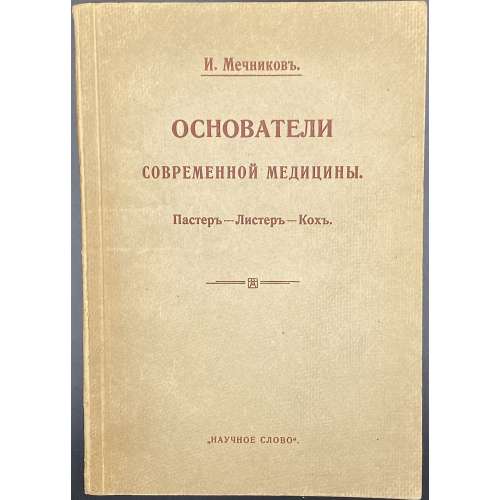 Paperback, 22.3 x 15.5 cm, publisher’s tan wrappers, brown lettering to front and spine, imprint and price to back, pp.: [1-3] 4-136 [2] blank/advert.; collated 8vo: [1]-88, 94 χ1, total 69 leaves plus 6 photomechanical plates, incl. frontispiece, four of them portraits. Title-page: И. Мечниковъ | ОСНОВАТЕЛИ | СОВРЕМЕННОЙ МЕДИЦИНЫ. | Пастеръ. — Листеръ. — Кохъ. | — | Изданiе | “НАУЧНАГО СЛОВА”. | Москва — 1915. Contributors and Characters: Илья Ильич Мечников [Élie Metchnikoff] (Russian, 1845 – 1916) – author. "Научное слово" – publisher. Типо-литография Товарищества И. Н. Кушнерев и Ко. — printer. Louis Pasteur (French, 1822 – 1895) – character. Joseph Lister (British, 1827 – 1912) – character. Robert Koch (German, 1843 – 1910) – character.
Paperback, 22.3 x 15.5 cm, publisher’s tan wrappers, brown lettering to front and spine, imprint and price to back, pp.: [1-3] 4-136 [2] blank/advert.; collated 8vo: [1]-88, 94 χ1, total 69 leaves plus 6 photomechanical plates, incl. frontispiece, four of them portraits. Title-page: И. Мечниковъ | ОСНОВАТЕЛИ | СОВРЕМЕННОЙ МЕДИЦИНЫ. | Пастеръ. — Листеръ. — Кохъ. | — | Изданiе | “НАУЧНАГО СЛОВА”. | Москва — 1915. Contributors and Characters: Илья Ильич Мечников [Élie Metchnikoff] (Russian, 1845 – 1916) – author. "Научное слово" – publisher. Типо-литография Товарищества И. Н. Кушнерев и Ко. — printer. Louis Pasteur (French, 1822 – 1895) – character. Joseph Lister (British, 1827 – 1912) – character. Robert Koch (German, 1843 – 1910) – character. -
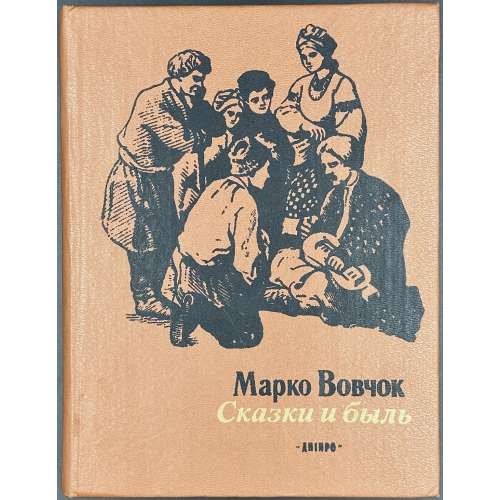 Small volume, 17.2 x 13.2 cm, brown buckram with vignette and lettering to front and spine, pp.: [1-4] 5-315 [5], illustrations: portrait, frontispiece, and two vignettes by I. Gavriliuk; text on Ukrainian and Russian. A reprint of the 1874 edition. Contents: Дев’ять братiв i десята сестриця Галя, Невiльничка, Ведмiдь, Кармелюк, Совершенная курица, Королевна Я, Затейник, Похождения домашнего учителя, Воришка, Чортова пригода. Title-page: Марко Вовчок | Сказки и быль | {vignette} | КИЕВ | ИЗДАТЕЛЬСТВО | ХУДОЖЕСТВЕННОЙ ЛИТЕРАТУРЫ | «ДНIПРО» | 1988 || Print run: 250,000 copies. Contributors: Марко Вовчок [Marko Vovchok; Марія Олександрівна Вілінська] (Ukrainian, 1833 – 1907) – author. Other variants: Markowovzok and Marko Vovtchok. Іван Михайлович Гаврилюк (Иван Михайлович Гаврилюк) (Ukrainian, 1939 – 2008) – artist.
Small volume, 17.2 x 13.2 cm, brown buckram with vignette and lettering to front and spine, pp.: [1-4] 5-315 [5], illustrations: portrait, frontispiece, and two vignettes by I. Gavriliuk; text on Ukrainian and Russian. A reprint of the 1874 edition. Contents: Дев’ять братiв i десята сестриця Галя, Невiльничка, Ведмiдь, Кармелюк, Совершенная курица, Королевна Я, Затейник, Похождения домашнего учителя, Воришка, Чортова пригода. Title-page: Марко Вовчок | Сказки и быль | {vignette} | КИЕВ | ИЗДАТЕЛЬСТВО | ХУДОЖЕСТВЕННОЙ ЛИТЕРАТУРЫ | «ДНIПРО» | 1988 || Print run: 250,000 copies. Contributors: Марко Вовчок [Marko Vovchok; Марія Олександрівна Вілінська] (Ukrainian, 1833 – 1907) – author. Other variants: Markowovzok and Marko Vovtchok. Іван Михайлович Гаврилюк (Иван Михайлович Гаврилюк) (Ukrainian, 1939 – 2008) – artist. -
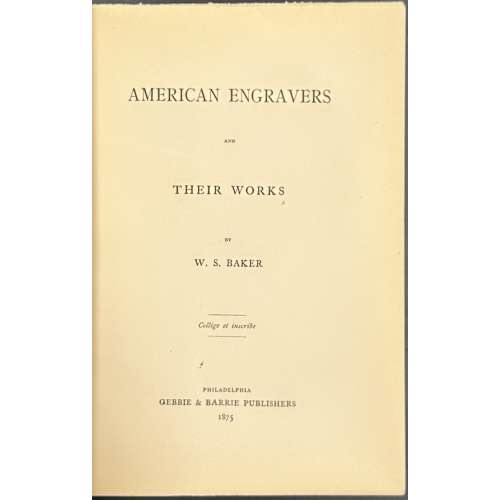 Hardcover, 19 x 13.8 cm, crimson buckram with tan paper label with lettering to spine; printed on laid paper; pp.: ffl [i-vi] vii-x] 11-184, collation 8vo, 1-118 124, total 92 leaves. Title-page: AMERICAN ENGRAVERS | AND | THEIR WORKS | BY | W. S. BAKER | Collige et inscribe | PHILADELPHIA | GEBBIE & BARRIE PUBLISHERS | 1875 || Motto: Collige et inscribe [Collect and record, lat.] Contributors: William Spohn Baker (American, 1824 – 1897) – author. George Gebbie (American, 1832 – 1892) – publisher. George Barrie (American, 1843 – 1918) – publisher. George R. Bonfield (British-American, 1802 – 1898) – dedicatee.
Hardcover, 19 x 13.8 cm, crimson buckram with tan paper label with lettering to spine; printed on laid paper; pp.: ffl [i-vi] vii-x] 11-184, collation 8vo, 1-118 124, total 92 leaves. Title-page: AMERICAN ENGRAVERS | AND | THEIR WORKS | BY | W. S. BAKER | Collige et inscribe | PHILADELPHIA | GEBBIE & BARRIE PUBLISHERS | 1875 || Motto: Collige et inscribe [Collect and record, lat.] Contributors: William Spohn Baker (American, 1824 – 1897) – author. George Gebbie (American, 1832 – 1892) – publisher. George Barrie (American, 1843 – 1918) – publisher. George R. Bonfield (British-American, 1802 – 1898) – dedicatee.


